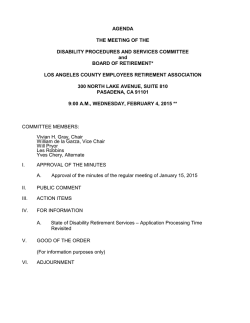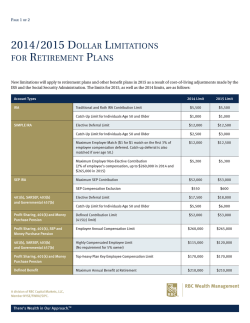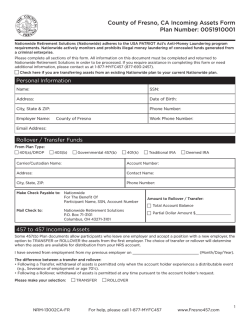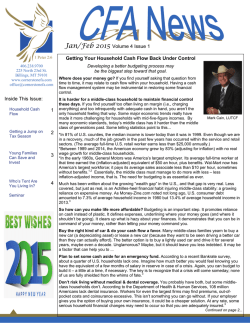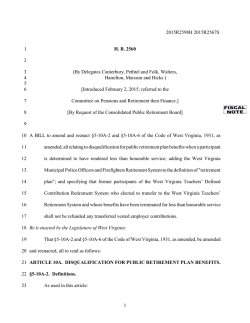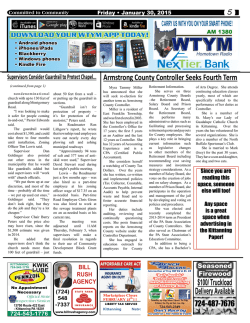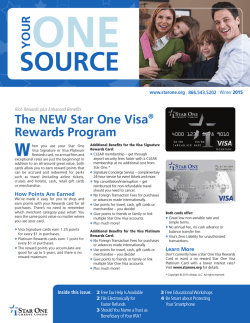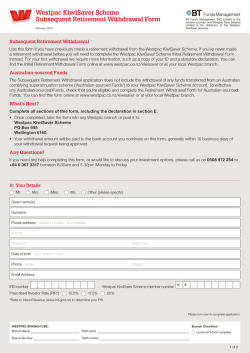
Application for Withdrawal of Contributions (Form Only)
SAVE RESET PRINT KPERS-13 Rev. 1/15 APPLICATION FOR WITHDRAWAL OF CONTRIBUTIONS For security reasons, do not submit application by e-mail. n Contact Us – toll free: 1-888-275-5737 • phone: 785-296-6166 • fax: 785-296-6638 e-mail: [email protected] • web site: www.kpers.org • mail: 611 S. Kansas Ave., Suite 100, Topeka, KS 66603 n Important – Kansas law requires that your application for withdrawal cannot be signed and submitted until 31 days after you end employment. KPERS will send a 1099-R tax form the following January for your federal income tax return. n Part A – Member Information 1. Social Security Number: ______-____-______ 3. Withdrawing From (mark all that apply): KPERS 2. Name (First, MI, Last): ______________________________ KP&F Judges 4. Telephone Number: (____) _________________________ 5. Mailing Address: _________________________________ 6. E-mail Address: __________________________________ City, State, Zip: ___________________________________ 7. Date You Last Earned Compensation (including any final or terminal leave period): ______/______/______ n Part B – Payment and Rollover Information Taxable Amount – Please choose one payment option for the taxable amount of your payment. Federal law requires a mandatory 20 percent federal tax withholding on taxable amounts paid directly to you. 1. Pay the entire taxable amount to me. Advance to Nontaxable Amount section. 2. Pay the entire taxable amount to a qualified defined contribution plan, traditional IRA or Roth IRA. Advance to #4. 3. Pay part of the taxable amount to a qualified defined contribution plan, traditional IRA or Roth IRA and the remainder to me. Enter the dollar amount to be paid to a rollover plan: $ _________________The minimum rollover is $500. Advance to #4. 4. If you marked #2 or #3, please list the name, address, account number and plan type of each rollover plan. Indicate percentage amounts to be paid to each plan. Total percentage amounts must be in whole numbers and equal 100 percent. Verify with your financial institution or rollover plan exactly how your withdrawal check should be made payable. a. Rollover Plan #1 Check payable to: ________________________________ Check mailed to: _____________________________________ Mailing Address: _________________________________ Mailing Address: _____________________________________ City, State, Zip: ___________________________________ City, State, Zip: ______________________________________ Account Number: ________________________________ Percentage to Be Rolled Over: ________________________ % Select Plan Type: Traditional IRA Roth IRA Qualified defined contribution plan b. Rollover Plan #2 Check payable to: ________________________________ Check mailed to: _____________________________________ Mailing Address: _________________________________ Mailing Address: _____________________________________ City, State, Zip: ___________________________________ City, State, Zip: ______________________________________ Account Number: ________________________________ Percentage to Be Rolled Over: ________________________ % Select Plan Type: Traditional IRA Roth IRA Qualified defined contribution plan Nontaxable Amount: Please choose one payment option for any nontaxable amount of your payment. 5. Pay the entire nontaxable amount to me. Advance to Part C. 6. Pay the entire nontaxable amount to a qualified defined contribution plan, traditional IRA or Roth IRA. Advance to #7. 7. If you marked #6 above, please list the name, address, account number and plan type of the rollover plan. Verify with your financial institution or rollover plan exactly how your withdrawal check should be made payable. a. Rollover Plan Check payable to: ________________________________ Check mailed to: _____________________________________ Mailing Address: _________________________________ Mailing Address: _____________________________________ City, State, Zip: ___________________________________ City, State, Zip: ______________________________________ Account Number: ________________________________ Select Plan Type: Traditional IRA Roth IRA Qualified defined contribution plan n Part C – Direct Deposit Information – If all or part of your contributions will be paid directly to you, the payment can be deposited directly into your checking or savings account. If you mark “no,” the payment will be mailed to the address you provided in Part A. Pre-paid cards are not accepted. 1. Direct Deposit: Yes No 2. Financial Institution: _____________________________________________________________________________________ 3. Location (City, State): ______________________________ 5. Type of Account: Checking 4. Telephone Number: (____) _________________________ Savings 6. Routing Number for Electronic Transfers:_____________________________________________________________________ 7. Bank Account Number: ___________________________________________________________________________________ n Part D – Member Statement and Signature – A notary is required or your application will not be processed. Note: Kansas law requires that your application for withdrawal cannot be submitted until 31 days after the date you end employment. This form cannot be signed until 31 days after the last date you earned compensation as reported by your employer. Your signature must be notarized. Count the first day after the date you last earned compensation as day one. You may then apply to withdraw contributions on day 31, or any date after, if you are not working in any KPERS-covered position. If you are appealing your dismissal, you are not eligible to withdraw your contributions. Continuing contract positions may apply to withdraw beginning October 1 following the end of the contract. 1. I certify that I am: Married Not Married “I fully understand that when the Retirement System office receives this completed and signed form, my decision to withdraw contributions is irrevocable. I forfeit all service credit and any right to disability, retirement and any other benefits that I am, or may be, entitled to receive in the future. If I am a non-vested member, I further understand that I would have up to five years from the date my employment ends to withdraw contributions. At the time the Retirement System receives this application I certify I am not employed in any position covered under the Retirement System, nor do I have any commitment for immediate employment covered under the Retirement System. I also understand my withdrawal application will not be processed until the Retirement System receives certain information from my former employer.” 2. Member Signature: ____________________________________________________ Month/Day/Year: ______/______/______ 3. Notary Public: State of ____________________________________ County of ___________________________________________________ Signed or attested before me on (date) _______________________ by (name of person) ___________________________________________ Notary Public Signature: ___________________________________ My appointment expires (month/day/year) ______/______/______. (SEAL) n Part E – Spousal Consent for Withdrawal of Vested Member’s Contributions Note: This section must be completed by your spouse if you are married and a vested member (see “Options to Consider Before You Withdraw”). A notary is required or your application will not be processed. 1. Spouse Name (First, MI, Last): ______________________________________________________________________________ “I hereby attest that I am the spouse of the previously-named member. I understand that my spouse is a vested member of the Retirement System, and that by consenting to the withdrawal of contributions, I am forfeiting any rights to future benefits I might have been entitled to, had my spouse not withdrawn the accumulated contributions.” 2. Spouse Signature: _____________________________________________________ Month/Day/Year: ______/______/______ 3. Notary Public: State of ____________________________________ County of ___________________________________________________ Signed or attested before me on (date) _______________________ by (name of person) ___________________________________________ Notary Public Signature: ___________________________________ My appointment expires (month/day/year) ______/______/______. (SEAL) Options To Consider Before You Withdraw What It Means to Be Vested When you are “vested,” it means you have earned enough service credit to guarantee a retirement benefit, even if you leave covered employment. KPERS 1, 2 & 3 • All KPERS members vest with five years of service. KP&F • Tier I members vest with 20 years of service. • Tier II members vest with 15 years of service. Judges • Judges vest when they are elected or appointed. If You Are Vested You are guaranteed a monthly retirement benefit for the rest of your life if you leave your contributions in your account. Often, if you have a significant amount of service, your vested benefit is more valuable than the amount of your actual contributions. If you keep your contributions with the Retirement System, you can apply for retirement benefits when you become eligible. Your contributions continue to earn interest and you can withdraw them at any time if you change your mind. If you decide to withdraw, consider a rollover to another retirement account. This will preserve your savings efforts and defer taxes. If you do not withdraw and you return to covered employment, you will immediately become a contributing active member again and keep the credit for your past public service. If You Are Not Vested You are not guaranteed a retirement benefit. You need to withdraw your account balance within five years of the date you end employment. Your contributions earn interest for five years (two years for KPERS 3 members). After five years, you forfeit your service. KPERS 1 mem- bers who reach age 65 within the five-year period may apply for retirement benefits. If you do not withdraw and you return to employment within five years, you will keep the credit for your past public service. You will return as a KPERS 3 member. Options for Withdrawing Your Contributions You can apply to withdraw your contributions any time 31 days after you end employment. If you withdraw, you will give up all Retirement System rights, benefits and service credit. Employer contributions made on your behalf stay with the Retirement System. You can receive your contributions plus interest as a direct payment to you or roll over the amount into an eligible retirement plan. The decision to withdraw could affect your financial future, especially if you have many years of public service and accumulated contributions. Please seek professional tax advice before withdrawing. Option 1 Roll your contributions over into an eligible retirement plan like a 457(b) deferred compensation plan, 403(b) annuity, 401(k) plan, individual retirement account (IRA), Roth IRA or a qualified retirement plan. Except for the Roth IRA, this option allows you to defer paying taxes until a later date. The type of plan that can accept your rollover is determined by whether or not you have already paid tax on your contributions. Option 2 Have your contributions paid directly to you. You may owe federal taxes and possibly a 10 percent federal penalty. Reasons to Roll Over Contributions Instead of Taking a Direct Payment • Preserve your past efforts toward saving for retirement. • Keep from paying taxes right away, giving your money more time to compound.* • Avoid paying federal penalties for early distribution. *A rollover to a Roth IRA is a taxable distribution in the year the funds are transferred. This type of rollover does have other tax advantages. The Withdrawal Process* 1. Complete the withdrawal application at least 31 days after you end employment, and send it to the Retirement System. 2. When we receive your completed application and any final payroll information, we will send payment within four weeks. 3. KPERS will send you a 1099-R form the following January for your income tax return. *KPERS 1 & KPERS 2 members: Interest is credited annually on June 30. If you withdraw before June 30, you will not receive your interest for the current year. Interest for KPERS 3 is credited quarterly. Application Instructions n Part A – Member Information Important: You must be off payroll from any Retirement System-covered position for at least 31 days before signing and submitting this application. You may not withdraw contributions if you are employed in a covered position, or you move to a non-covered position with the same employer. Kansas law requires that your application for withdrawal cannot be signed and submitted until 31 days after you end employment. Interest Crediting: For KPERS 1 and KPERS 2 members, interest is credited annually on June 30. If the Retirement System receives your application before June 30, you will not receive your interest for the current year. For KPERS 3 members, interest is credited quarterly. 1. Enter your Social Security number. 2. Enter your current legal first name, middle initial and last name. If the name on your KPERS account is different, name change documents will be required. 3. Mark the corresponding box to indicate the plan(s) you are withdrawing from. If you are withdrawing from more than one plan (for example, KPERS and KP&F), submit two applications if you are choosing different payment options for each plan. 4-6. Enter the indicated personal information. Enter the mailing address to which the Retirement System should direct all communications on your behalf. 7. Enter the date you last earned compensation, as reported by your employer. This date may be different than your last day at work due to paid leave, etc. If you are a school employee under contract, enter your contract end date. Continuing contract personnel cannot withdraw until 31 days after the contract end date. n Part B – Payment Information Important: Your contributions can be paid directly to you or rolled over to an eligible retirement plan. Read the “Tax Information Regarding Plan Payments” section before completing Part B. Federal law requires a mandatory 20 percent tax withholding on taxable amounts paid directly to you. Taxable amounts that are rolled over to a qualified defined contribution plan or traditional IRA will not be taxed until taken out of the plan. You may be eligible to establish a Roth IRA to receive a direct rollover. You are responsible for determining if you meet the Internal Revenue Service’s income limits and filing status requirements for establishing a Roth IRA. Please seek professional tax advice if you are considering this option. A rollover to a Roth IRA is taxable and will be subject to federal income tax. KPERS does not withhold federal income tax for a rollover to a Roth IRA. We will send you a 1099-R tax form the following January for your federal income tax return. Taxable Amount 1. Mark this box to have the entire taxable amount paid directly to you. The Retirement System will withhold a required 20 percent for federal taxes. Advance to Nontaxable Amounts. 2. Mark this box to have the entire taxable amount paid to a qualified defined contribution plan, traditional IRA or Roth IRA. Advance to #4. 3. Mark this box to have part of the taxable amount paid to a qualified defined contribution plan, traditional IRA or Roth IRA and the remainder to you. Enter the rollover amount in the space provided. The minimum rollover is $500. The Retirement System will withhold a required 20 percent for federal taxes from the portion paid to you. Advance to #4. 4. If you marked #2 or #3, indicate the name, mailing address, account number and plan type of each rollover plan. If different, provide address where the check should be mailed. Verify with your financial institution or plan exactly how the check should be made payable. Indicate the percentage of payment to be placed within each plan. The total percentage amounts must be in whole numbers and equal 100 percent. Nontaxable Amount Note: You may not have a nontaxable amount. 1. Mark this box to have the entire nontaxable amount paid to you. Advance to Part C. 2. Mark this box to have the entire nontaxable amount paid to a qualified defined contribution plan, traditional IRA or Roth IRA. Advance to #7. 3. If you marked #6, indicate the name, address, account number and plan type of the rollover plan. If different, provide address where the check should be mailed. Verify with your financial institution or plan exactly how your withdrawal check should be made payable. State of Kansas Set-Off Program The State of Kansas Set-off program is a program used to collect certain government debts. If you owe a debt to a Kansas state agency, municipality, municipal court or district court, your payment will be applied (set-off) to that delinquent debt. If your withdrawal payment is set-off, additional time will be required to process your payment. For more information on the Set-off Program, visit www.da.ks.gov/ar/setoff or call the Customer Call Center at (785) 296-4628. Application Instructions (cont.) n Part C – Direct Deposit Information Note: Please verify the financial account information with your financial institution before completing this section. 1. Indicate whether you want your payment deposited into your personal account. 2. Enter the name of the financial institution. n Part E – Spousal Consent for Withdrawal of Vested Member’s Contributions Note: Kansas law recognizes a spouse’s financial interest in a vested member’s decision to withdraw Retirement System contributions by requiring the member’s spouse to consent to the withdrawal. His or her signature must be notarized for KPERS to accept this application. 6. Enter the routing number for electronic transfers. This may be different from the routing number for the branch bank where the account is held. When a Retirement System member is vested, it means that the member is guaranteed retirement benefits upon reaching the statutory retirement age. Often, if a member has a significant amount of service, the vested benefit is more valuable than the amount of the actual contributions. The decision to withdraw contributions once a member is vested could affect his or her financial future, especially if the member has many years of public service and accumulated contributions. If you haven’t already, take this opportunity to discuss your financial situation and retirement plans with your spouse. 7. Enter the account number to receive the payment. 1. Spouse prints his or her name. 3. Enter the city and state where the financial institution is located. 4. Enter the telephone number of the financial institution. 5. Indicate the type of account. Note: Your signature must be notarized or KPERS cannot process your withdrawal. 2. Spouse should read and understand the statement, then sign and date the form to attest that he or she understands and agrees with the member’s decision to withdraw contributions. 1. Indicate your marital status. 3. Spouse’s signature must be notarized. n Part D – Member Statement and Signature 2. Read and understand the statement, then sign and date the form. This form cannot be signed until at least 31 days after last date you earned compensation as reported in your employer. 3. Your signature must be notarized. Important: By signing this application, you irrevocably forfeit all service and any right to disability, retirement and any other benefits you may be entitled to as a Retirement System member. This includes any benefits you are currently receiving or could receive in the future. A leave of absence not exceeding one year, military service or a total disability is not considered an end in employment or a break in continuous employment, unless you resign following that leave, service or disability. If you recently left employment, your withdrawal application cannot be processed until the Retirement System receives the proper report and remittance from your former employer.
© Copyright 2025

